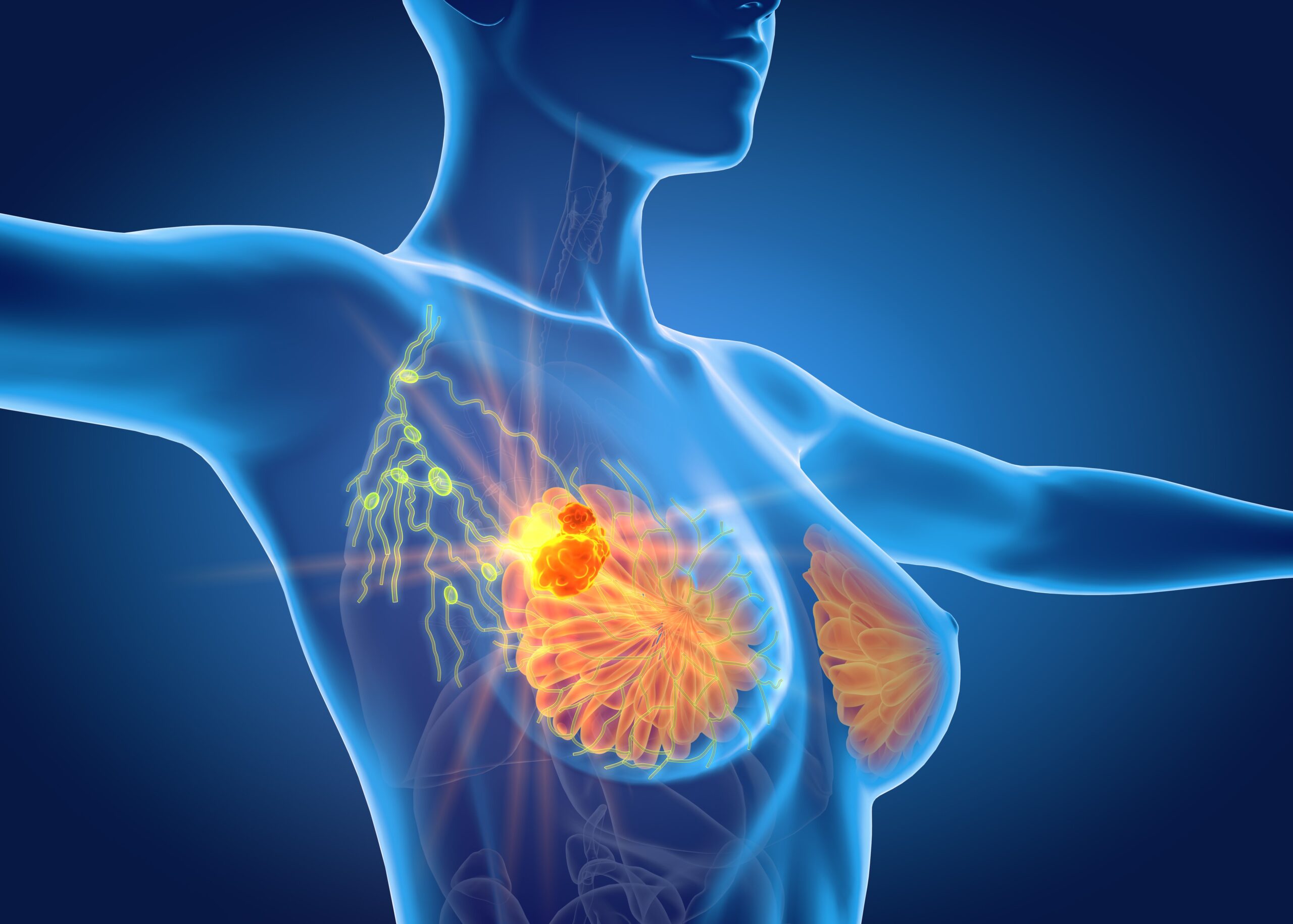Note: Video captions are generated with the assistance of AI and may contain errors.
John P. Berdahl, MD, a surgeon at Vance Thompson Vision and a professor at the University of South Dakota, spoke on the lens implantation strategies for patients…

Note: Video captions are generated with the assistance of AI and may contain errors.
John P. Berdahl, MD, a surgeon at Vance Thompson Vision and a professor at the University of South Dakota, spoke on the lens implantation strategies for patients…

The addition of the PI3K/AKT/mTOR (PAM) inhibitor gedatolisib to fulvestrant (Faslodex), with or without palbociclib (Ibrance) led to clinically meaningful and statistically significant improvements in progression-free survival (PFS) among patients with hormone receptor (HR)-positive, human epidermal growth factor receptor 2 (HER2)-negative, PIK3CA wild-type advanced breast cancer following progression on, or after, treatment with a CDK4/6 inhibitor and an aromatase inhibitor. 1,2
The benefits of PAM inhibition were seen in results from the phase 3 VIKTORIA-1 trial (NCT05501886) that were presented at the
“VIKTORIA-1 is the first study to demonstrate a statistically significant and clinically meaningful improvement in progression-free survival with PAM inhibition in patients with PIK3CA wild-type disease, all of whom received prior CDK4/6 inhibitor,” Sara A. Hurvitz, MD, FACP, senior vice president and director, Clinical Research Division, Fred Hutch, said during a presentation of the data.
Compared with fulvestrant alone (arm C), both the triplet of gedatolisib, fulvestrant, and palbociclib (arm A) and doublet regimen of gedatolisib plus fulvestrant (arm B) induced superior PFS. The triplet reduced the risk of disease progression by 76% compared with fulvestrant alone (median PFS 9.3 months [95% CI, 7.2-16.6] vs 2.0 months [95% CI, 1.8-2.3], respectively; hazard ratio, 0.24; 95% CI, 0.17-0.35; P <.0001). The doublet reduced the risk of progression by 67% vs fulvestrant alone (7.4 months [95% CI, 5.5-9.9] vs 2.0 months [95% CI. 1.8-2.3], respectively; hazard ratio, 0.33; 95% CI, 0.24-0.48; P <.0001).
Superior median PFS was consistent across subgroup analyses for both the triple and doublet regimens. Most noteworthy, according to Hurvitz, was that patients who received prior palbociclib benefited from the triplet regimen. “This is the first time that data in the randomized setting suggested benefit to palbociclib rechallenge,” she said.
When comparing median PFS benefit between arms A and B, the triplet regimen demonstrated higher clinical benefit in almost all subgroups, including those who were pre/perimenopausal, endocrine therapy resistant, with visceral metastases, and for those who had previously received treatment with palbociclib.
At a data cutoff of May 30, 2025, data for overall survival (OS) were immature, with only 48% of the protocol specified events, Hurvitz noted. Compared with 18.5 months (95% CI, 15.8-NE) in the monotherapy arm, the triplet and doublet regimens, respectively, demonstrated a median OS of 23.7 months (95% CI, 21.4-not estimable [NE]; hazard ratio, 0.69; 95% CI, 0.43-1.12; P = .1328) and not reached (NR; 95% CI, NR-NR; hazard ratio, 0.74; 95% CI, 0.46-1.19; P = .2122).
Sixty-three patients in the fulvestrant arm crossed over to the triplet (n = 52; 48.1%) or doublet (n = 11; 10.2%) regimens. This could impact overall survival, Hurvitz said, adding that a sensitivity analysis performed at the time of crossover showed a greater separation of the OS curves in favor of the triplet (hazard ratio, 0.60; 95% CI, 0.35-1.04; P = .0698) and doublet (hazard ratio, 0.56; 95% CI, 0.33-0.97; P = .0393) regimens.
“The study is continuing to follow patients for overall survival, with final analysis is anticipated about 48 months after the first patient was randomized, or early 2027,” she added.
Tumor response was also superior in both the triple and doublet regimens, compared with fulvestrant alone.
In the triplet arm, the ORR was 31.5%. There was 1 complete response (CR), 38 partial responses (PRs), 67 patients with stable disease (SD), and 17 patients with progressive disease (PD). Further, the clinical benefit rate (CBR; defined as CR, PR, and SD >24 weeks) among this arm was 50%, with a disease control rate (DCR; defined as CR, PR, and SD) of 85.5%. The DOR was a median of 17.5 months (95% CI, 8.8-NE).
In the doublet arm, the ORR was 28.3%, with no CRs, 32 PRs, 55 with SD, and 26 with PD. CBR and DCR were 48.7% and 77.0%, respectively, with a median DOR of 12.0 months (95% CI, 8.1-NE).
Lastly, in the monotherapy arm, the ORR was 1.0%, with no CRs, 1 PR, 40 with SD, and 62 with PD. The CBR and DCR were 11.4% and 39.0%, respectively, with the median DOR not reached.
Treatment with gedatolisib was generally well tolerated in both arms with no new safety signals, according to Hurvitz.
In total, 3 patients in the triplet arm and 4 in the doublet arm discontinued treatment due to a treatment-related adverse event (TRAE). Two deaths occurred in the triplet therapy arm.
Treatment-related AEs of interest with the triplet and doublet regimens were stomatitis (any grade, 69.2% and 56.9%, respectively), rash (any grade, 27.7% and 32.3%), diarrhea (any grade, 16.9% and 12.3%), and hyperglycemia (any grade, 9.2% and 11.5%).
The PAM pathway drives breast cancer growth and contributes to endocrine and CDK4/6 inhibitor resistance; however, as most available therapies are indicated only for patients with PI3K-pathway activation, an unmet need remains for those with wild type disease.
“Therapeutic attempts to completely block the PAM pathway have been limited by toxicity,” Hurvitz explained. “Most available therapies target a single component of the pathway and have modest efficacy limited to biomarker selected patient populations.”
Following preliminary clinical activity of gedatolisib in combination with palbociclib and fulvestrant as a therapy in the second line and beyond among patients with HR-positive, HER2-negative advanced breast cancer, the investigators aimed to evaluate the highly potent multitarget PAM inhibitor in this patient population following progression on a CDK4/6 inhibitor and aromatase inhibitor.
In the open-label, randomized phase 3 trial, 392 patients were randomized 1:1:1 to receive either of the following regimens:
Patients treated with fulvestrant monotherapy were allotted the option to cross over to arms A or B at progression.
Pre- and postmenopausal patients were eligible for the trial if they had progression on or after treatment with a CDK4/6 inhibitor and aromatase inhibitor, 2 or more lines of prior endocrine therapy for advanced breast cancer, measurable disease via RECIST v1.1, and a screening result for PIK3CA status. Patients were ineligible if they had type 2 diabetes mellitus with a glycated hemoglobin of greater than 6.4% or type 1 diabetes mellitus; prior therapy with an mTOR, PI3K, or AKT inhibitor; or chemotherapy treatment for their advanced breast cancer.
Patients were stratified by lung/liver metastases, time to progression on their immediate prior therapy, and region.
The co-primary end points were PFS in arm A compared with arm C and PFS in arm B vs arm C. Secondary end points included OS, ORR, safety, and quality of life.
Demographics and baseline characteristics were generally well balanced across treatment arms.
“We are very excited that treatment with gedatolisib combined with fulvestrant with or without palbociclib was well-tolerated by the VIKTORIA-1 patients and that only a few patients discontinued treatment due to an adverse event,” said Igor Gorbatchevsky, MD, chief medical officer of Celcuity, in a press release.2
“This safety profile combined with the 7.3- and 5.4-months incremental improvement in median PFS relative to fulvestrant for the gedatolisib regimens, offer potentially paradigm shifting results for patients with HR-positive, HER2-negative, PIK3CA wild-type advanced breast cancer,” he added.
According to the release, a rolling new drug application (NDA) has been submitted in tandem with the FDA’s Real-Time Oncology Review Program based on data from the PIK3CA wild-type cohort of the phase 3 VIKTORIA-1 trial. The NDA is expected to be completed before the end of 2025, and topline data from the trial is expected in the first half of 2026. The phase 3 VIKTORIA-2 trial (NCT06757634), designed to evaluate gedatolisib in the frontline setting, is ongoing.


Neoadjuvant fam-trastuzumab deruxtecan-nxki (T-DXd; Enhertu) followed by paclitaxel, trastuzumab (Herceptin), and pertuzumab (Perjeta; THP) yielded benefit in pathologic complete response (pCR) rates compared with dose-dense doxorubicin and cyclophosphamide plus THP (ddAC-THP) in patients with high-risk, HER2-positive early breast cancer, according to data from the phase 3 DESTINY-Breast11 trial (NCT05113251).1
Findings presented at the 2025 ESMO Congress demonstrated that patients treated with T-DXd followed by THP (n = 321) experienced a pCR rate of 67.3% compared with 56.3% for those given ddAC-THP (n = 320; difference, 11.2%; 95% CI, 4.0%-18.3%; P = .003). Notably, the pCR benefit was observed in the hormone receptor–positive population, where the pCR rate was 61.4% in the T-DXd arm (n = 236) vs 52.3% in the ddAC-THP arm (n = 235; difference, 9.1%; 95% CI, 0.2%-17.9%), as well as the hormone receptor–negative population, where the respective pCR rates for the T-DXd arm (n = 83) and ddAC-THP arm (n = 85) were 83.1% and 67.1% (difference, 16.1%; 95% CI, 3.0%-28.8%).
“DESTINY-Breast11 showed the highest reported pCR rate in HER2-positive early breast cancer for a registrational study in the neoadjuvant setting, despite—if you want to do cross-trial comparisons—a high prevalence of hormone receptor–positive disease and a high-risk population,” lead study author Nadia Harbeck, MD, PhD, said in a presentation of the data.
Harbeck is director of the Breast Center and chair for Conservative Oncology at the Department of OB&GYN at LMU University Hospital in Munich, Germany.
Harbeck noted that current neoadjuvant standard-of-care (SOC) regimens for HER2-positive early breast cancer have remained unchanged for more than a decade. As such, investigators sought to evaluate T-DXd–based treatment in this population with the goal of improving efficacy and safety vs the current SOC.
The randomized, global, multicenter, open-label study enrolled patients with previously untreated HER2-positive early breast cancer who had high-risk disease, defined as ≥cT3 and N0-3 or cT0-4 and N1-3; or inflammatory breast cancer. Patients were allowed to enroll, irrespective of hormone receptor status.
Patients were randomly assigned in a 1:1:1 fashion to receive T-DXd followed by THP; ddAC-THP; or T-DXd alone, followed by surgery in all arms. In the first arm, patients received 4 cycles of T-DXd followed by 4 cycles of THP. In the second, ddAC was administered for 4 cycles, followed by 4 cycles of THP. In the final arm, patients received T-DXd alone for 8 cycles.
Notably, the T-DXd monotherapy arm was closed in March 2024, following a recommendation from the study’s independent data monitoring committee.
After surgery, study protocols called for the following treatments, irrespective of arm:
The study’s primary end point was pCR rate (ypT0/Tis ypN0) per blinded independent central review (BICR) assessment. Secondary end points included BICR-assessed pCR rate (ypT0 ypN0), event-free survival (EFS), safety, pharmacokinetics, invasive disease-free survival, overall survival, and health-related quality of life. Residual cancer burden (RCB) was an additional outcome measured during the study.
At data cutoff, 16.9% of patients in the T-DXd plus THP arm discontinued a study drug, including T-DXd (2.8%), paclitaxel (14.4%), trastuzumab (2.2%), and pertuzumab (2.2%); 97.2% of patients in this arm proceeded to surgery. In the ddAC-THP arm, 13.8% of patients had discontinued any study treatment, including AC (2.9%), paclitaxel (12.0%), trastuzumab (3.0%), and pertuzumab (3.7%); 93.8% of patients in this arm underwent surgery. In the T-DXd monotherapy arm (n = 286), 18.4% of patients discontinued study treatment, and 95.8% underwent surgery.
Regarding post-neoadjuvant treatments, 99.1% of evaluable patients in the T-DXd arm who achieved a pCR (n = 226) underwent any adjuvant therapy, comprising any cytotoxic chemotherapy regimen (5.8%), any T-DM1–containing regimen (1.8%), and any trastuzumab-containing regimen (94.2%). In the ddAC-THP, 98.4% of patients who achieved a pCR (n = 190) underwent any adjuvant therapy, including any cytotoxic chemotherapy regimen (5.8%), any T-DM1–containing regimen (2.1%), and any trastuzumab-containing regimen (91.6%).
For patients who did not achieve a pCR, any adjuvant therapy was administered to 89.5% of patients in the T-DXd plus THP arm (n = 95) and 82.3% of patients in the ddAC-THP arm (n = 130). In the experimental group, adjuvant therapies included any cytotoxic chemotherapy regimen (10.5%), any T-DM1–containing regimen (52.6%), and any trastuzumab-containing regimen (38.9%). These respective rates were 9.2%, 56.9%, and 26.2% in the control group.
In the T-DXd plus THP and ddAC-THP arms, the median age was 50 years (range, 25-82) and 50 years (range, 23-79), respectively. All patients in both arms were female. The highest proportion of patients in each arm was from Asia (T-DXd plus THP, 47.4%; ddAC-THP, 47.5%) and were Asian (49.8%; 49.1%). Most patients had an ECOG performance status of 0 (86.6%; 87.5%), had immunohistochemistry 3+ HER2-positive disease (87.2%; 88.4%), had cT0-2 tumors (54.8%; 58.8%), and had positive lymph nodes (89.4%; 87.8%).
Findings also showed that 81.3% of patients in the T-DXd plus THP arm had no RCB (RCB-0) or minimal RCB (RCB-1) in resected breast or lymph node tissue compared with 69.1% in the ddAC-THP arm (difference, 12.2%). In the hormone receptor–positive population, the RCB-0 plus RCB-1 rates were 78.0% for T-DXd plus THP vs 64.7% for ddAC-THP; these respective rates were 90.4% and 81.2% in the hormone receptor–negative population.
Investigators also reported an EFS trend favoring T-DXd plus THP, with data at 4.5% maturity (HR, 0.56; 95% CI, 0.26-1.17). Maturity for the data cutoff of the trial’s final analysis is predicted at approximately 10%. The 24-month EFS rates were 96.9% (95% CI, 93.5%-98.6%) in the T-DXd plus THP arm vs 93.1% (95% CI, 88.7%-95.8%) in the ddAC-THP arm.
Any-grade adverse effects (AEs) occurred in 98.1% of patients in the T-DXd plus THP arm compared with 98.7% of patients in the ddAC-THP arm. The respective rates of grade 3 or higher AEs were 37.5% and 55.8%. Any-grade serious AEs were reported in 10.6% and 20.2% of patients, respectively.
In the T-DXd plus THP arm, AEs led to dose any dose reduction, any drug interruption, and any treatment discontinuation in 18.1%, 37.8%, and 14.1% of patients, respectively. In the ddAC-THP group, these rates were 19.2%, 54.5%, and 9.9%, respectively. AEs led to death in 0.6% of patients in both arms. AEs led to delays in surgery in 3.4% of patients in the experimental arm vs 2.6% of patients in the control arm.
Regarding AEs of special interest, any-grade drug-related adjudicated interstitial lung disease (ILD) was 4.4% in the T-DXd plus THP arm vs 5.1% in the ddAC-THP arm. The rates of grade 3 or higher ILD were 0.6% and 1.9%, respectively. Grade 5 ILD occurred in 1 patient (0.3%) in both groups. Any-grade left ventricular dysfunction occurred in 1.3% of patients in the experimental arm vs 6.1% of patients in the control arm. The rates of grade 3 or higher left ventricular dysfunction were 0.3% and 1.9%, respectively, although no grade 5 events were reported in either group.
Any-grade treatment-emergent AEs reported in at least 20% of patients in either arm included nausea (T-DXd plus THP, 64.7%; ddAC-THP, 51.6%), diarrhea (58.8%; 54.2%), alopecia (47.5%; 49.0%), fatigue (41.3%; 54.8%), increased transaminase levels (34.4%; 33.7%), neutropenia (29.1%; 44.2%), constipation (29.1%; 24.4%), vomiting (28.8%; 21.2%), peripheral neuropathy (25.9%; 20.8%), anemia (22.8%; 49.7%), stomatitis (18.4%; 27.9%), and leukopenia (17.2%; 23.4%).
When the T-DXd monotherapy arm, patients were allowed to remain on therapy or immediately switch to local SOC. If patients switched therapy, they were classified as having a non-pCR.
Findings from the monotherapy arm showed that patients (n = 286) achieved a pCR rate of 43.0% at the primary analysis and 51.4% at a prespecified supplementary analysis. EFS data were similar between T-DXd monotherapy and ddAC-THP (HR, 0.82; 95% CI, 0.41-1.62), and the 24-month EFS rate in the T-DXd monotherapy group was 94.4% (95% CI, 90.5%-98.7%).
Regarding safety, 97.5% of patients treated with T-DXd alone (n = 283) experienced any-grade AEs, 22.6% had grade 3 or higher AEs, and 10.2% had any-grade serious AEs. AEs led to dose reduction, drug interruption, and treatment discontinuation in 6.7%, 18.0%, and 7.8% of patients, respectively. One patient (0.4%) experienced an AE that led to death. AEs led to surgical delay in 6.4% of patients.
The rate of any-grade, drug-related adjudicated ILD was 4.9% in the T-DXd monotherapy arm, although all instances were grade 1 or 2. Left ventricular dysfunction occurred in 0.7% of patients, all at grade 1 or 2.
Based on data from DESTINY-Breast11, the FDA accepted a supplemental biologics license application seeking the approval of neoadjuvant T-DXd followed THP for the treatment of adult patients with high-risk, HER2-positive (IHC 3+ or in situ hybridization–positive), stage II/III breast cancer.2
The FDA has assigned a target action date of May 18, 2026, under the Prescription Drug User Fee Act.
“DESTINY-Breast11 results support T-DXd [plus] THP as a more effective and less toxic neoadjuvant treatment compared with ddAC-THP, and it may become the preferred regimen for patients with high-risk, HER2-positive early breast cancer,” Harbeck concluded in her presentation.1
Disclosures: Harbeck reported receiving honoraria from AstraZeneca, Daiichi Sankyo, Gilead, Lilly, Menarini Stemline, MSD, Novartis, Pfizer, Pierre Fabre, Roche, Viatris, and Zuellig Pharma; serving as a consultant or advisor for Exact Sciences, Gilead, Pfizer, Roche, and Sandoz; having an institutional site contract with AstraZeneca; serving as a data safety monitoring board or advisory board member for Gilead, IQVIA, and Roche; and having ownership interested in the West German Study Group.

Google introduces new Gmail account recovery mode.
SOPA Images/LightRocket via Getty Images
Updated October 19 with a new lock screen recovery feature specifically for Android smartphone users, as well as a warning from Check Point Software…

“Magic” was the word Guillaume Cizeron and Laurence Beaudry-Fournier. used to describe their comeback to the international stage as they triumphed on home ice at the 2025 Grand Prix de France on Sunday, 19 October.
With their whopping 133.02…


Science matters….